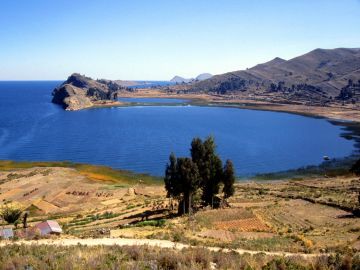Building Capacity in two vulnerable semi-arid Mountain Regions in Bolivia


Lake Titicaca, Bolivia
Climatic hazards in Bolivia have become an additional challenge to achieving poverty reduction objectives. The costs of the ‘El Niño event in 1997/98 represented about 6% of the GDP and the flooding of the Mamore River in 2006/07 exceeded 400 million US$ (CEPAL 2007). In urban areas, the effects of climatic events have caused infrastructure loss and in rural areas agricultural activities have been seriously affected, threatening the sustainability of local livelihoods and causing massive migrations to the country’s main cities. The negative social indicators and the high poverty incidence in Bolivia, as well as a narrow economy mainly based on agricultural production and primary resource extraction, increase the country’s vulnerability to climatic hazards resulting in large impacts on the productive sectors and human development.
Because of high quality water resources, the mountainous regions in Bolivia sustain the highest rural population densities in the country. In these regions the level of poverty is high – more than 70% of the local population lives in poverty conditions – and even though poverty reduction measures are being implemented, poverty conditions and vulnerability of these human settlements may be enhanced by climate change. The population settled in these regions depends largely on the ecosystems’ services for their productive activities and subsistence based mainly on agriculture. Their production systems are particularly vulnerable due to the low level of technology, insecure land tenure, limited size of land property and poor economic diversification. Hence, the impacts of climate change effects on the ecosystems of mountainous regions can have serious consequences on the local livelihoods in these regions which affect human development conditions. Climate change effects can not only negatively impact their livelihoods (particularly food security), but also provoke an emergence and expansion of vector transmissible diseases such as Malaria and Chagas increasing the pressure on human health in these regions.
The situation described above is particularly sensitive in semi-arid mountainous regions where scarcity of water resources can be exacerbated by climate change. In these regions water availability can decrease to 50% of the potential resources due to temperature rise and precipitation decrease (Iglesias et al., 2005). According to future projections on climate change in Bolivia, the inter-Andean xeric valleys will be one of the most vulnerable regions due to its xeric climate and orographic isolation. Other highly vulnerable ecosystems to climate change are the ecotones of the sub-Andean valleys that have periodic rainfall.
To evaluate this situation and find possible preventive measures, two vulnerable semi-arid mountainous regions in Bolivia have been selected as the scope of the study: the region of the Lake Titicaca and the region of Vallegrande (see map above right). These regions were selected as pilot studies based on physiographic criteria, watershed management considerations and political division. The project will focus mainly on human subsistence systems by assessing food security and human health in both regions. Although the focus is placed on those two sectors, water resources play a fundamental role in the assessment, mainly due to the potential direct impacts of climate change on the local hydrology and the effects this may cause on local livelihoods.
The objectives of the project are:
- to improve the understanding of climate change risks, the vulnerability and adaptive capacity of local communities in semi-arid mountainous regions in Bolivia.
- to develop a cost effective methodology for rapid appraisal and monitoring of climate change vulnerability.
- to build adaptive capacity in these regions using a participatory approach to identify preventive adaptation measures focusing on food security and human health. The results of the study will complement policies and measures implemented at the local and national levels.
This project was carried out under the Netherlands Climate Assistance Programme (NCAP) which was funded by the Netherlands Ministry of Foreign Affairs. ETC International managed the overall NCAP project. Javier Gonzales managed the Bolivia part of the NCAP project.
Next. . .
On to:
Methodology of Bolivia NCAP Project
Key findings from Bolivia NCAP Project
(0) Comments
There is no content